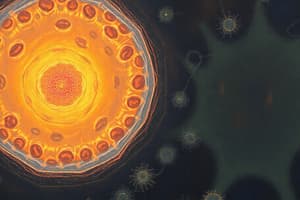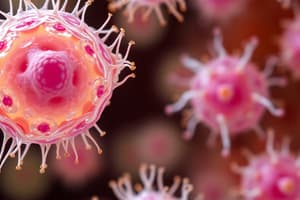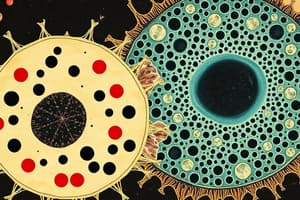Podcast
Questions and Answers
How does the surface area to volume ratio limit cell size and why is a high ratio important?
How does the surface area to volume ratio limit cell size and why is a high ratio important?
As a cell grows, volume increases faster than surface area. A high ratio is needed for efficient exchange of materials with the environment.
Describe how the structure of the plasma membrane contributes to its function as a selectively permeable barrier.
Describe how the structure of the plasma membrane contributes to its function as a selectively permeable barrier.
The phospholipid bilayer with hydrophobic tails and hydrophilic heads restricts passage of hydrophilic molecules, while proteins facilitate transport of specific molecules.
What is the role of the nuclear envelope and its pores in maintaining the integrity and function of the nucleus?
What is the role of the nuclear envelope and its pores in maintaining the integrity and function of the nucleus?
The envelope separates the nucleus from the cytoplasm, while the pores regulate transport of molecules in and out.
Explain how the rough ER and Golgi apparatus work together in the production and processing of proteins for secretion from the cell.
Explain how the rough ER and Golgi apparatus work together in the production and processing of proteins for secretion from the cell.
Describe the endosymbiotic theory and provide evidence supporting the idea that mitochondria and chloroplasts were once independent prokaryotic cells.
Describe the endosymbiotic theory and provide evidence supporting the idea that mitochondria and chloroplasts were once independent prokaryotic cells.
How do lysosomes contribute to both cellular recycling (autophagy) and programmed cell death (apoptosis)?
How do lysosomes contribute to both cellular recycling (autophagy) and programmed cell death (apoptosis)?
Compare and contrast the roles of microfilaments, intermediate filaments, and microtubules in the structure and function of the cytoskeleton.
Compare and contrast the roles of microfilaments, intermediate filaments, and microtubules in the structure and function of the cytoskeleton.
Explain how cell walls in plant cells contribute to the overall structure and function of plant tissues and organs.
Explain how cell walls in plant cells contribute to the overall structure and function of plant tissues and organs.
Describe the main steps involved in cellular respiration, indicating where each step occurs within the cell and its primary purpose.
Describe the main steps involved in cellular respiration, indicating where each step occurs within the cell and its primary purpose.
Outline the major differences between mitosis and meiosis in terms of their purpose, process, and the resulting daughter cells.
Outline the major differences between mitosis and meiosis in terms of their purpose, process, and the resulting daughter cells.
Explain the basic principles of cell signaling, including reception, transduction, and response, and provide an example of a signaling pathway.
Explain the basic principles of cell signaling, including reception, transduction, and response, and provide an example of a signaling pathway.
How do tight junctions, adherens junctions/desmosomes and gap junctions facilitate cell-to-cell communication and maintain tissue integrity?
How do tight junctions, adherens junctions/desmosomes and gap junctions facilitate cell-to-cell communication and maintain tissue integrity?
Describe the process of cell differentiation, and explain how differential gene expression leads to specialized cell types.
Describe the process of cell differentiation, and explain how differential gene expression leads to specialized cell types.
How do prokaryotic cells differ structurally from eukaryotic cells, and explain the functional significance of these differences?
How do prokaryotic cells differ structurally from eukaryotic cells, and explain the functional significance of these differences?
Explain the role of ribosomes in protein synthesis and describe how their location (free in the cytoplasm or bound to the ER) influences the destination of the proteins they produce.
Explain the role of ribosomes in protein synthesis and describe how their location (free in the cytoplasm or bound to the ER) influences the destination of the proteins they produce.
Flashcards
Cells
Cells
Basic structural and functional units of life.
Cell Theory
Cell Theory
Cells are the basic units, all organisms are composed of cells, and new cells come from existing cells.
Prokaryotic Cells
Prokaryotic Cells
Cells lacking a nucleus or other membrane-bound organelles.
Eukaryotic Cells
Eukaryotic Cells
Signup and view all the flashcards
Plasma Membrane
Plasma Membrane
Signup and view all the flashcards
Cytoplasm
Cytoplasm
Signup and view all the flashcards
Nucleus
Nucleus
Signup and view all the flashcards
Ribosomes
Ribosomes
Signup and view all the flashcards
Endoplasmic Reticulum (ER)
Endoplasmic Reticulum (ER)
Signup and view all the flashcards
Golgi Apparatus
Golgi Apparatus
Signup and view all the flashcards
Lysosomes
Lysosomes
Signup and view all the flashcards
Mitochondria
Mitochondria
Signup and view all the flashcards
Chloroplasts
Chloroplasts
Signup and view all the flashcards
Cytoskeleton
Cytoskeleton
Signup and view all the flashcards
Cellular Respiration
Cellular Respiration
Signup and view all the flashcards
Study Notes
- Cells represent the fundamental structural and functional units of life.
- Cell biology focuses on the study of cell structure and function.
- The cell theory comprises that all living organisms consist of cells, cells constitute the basic structural and functional units in living organisms, and new cells arise from pre-existing cells.
Two Main Types of Cells
- Prokaryotic cells are characterized by the absence of a nucleus and other membrane-bound organelles.
- Bacteria and Archaea are categorized as prokaryotic cells.
- Eukaryotic cells possess a nucleus and various membrane-bound organelles.
- Protists, fungi, plants, and animals are classified as eukaryotic cells.
Prokaryotic Cell Structure
- A plasma membrane encloses the cell.
- The cytoplasm occupies the region within the plasma membrane.
- DNA resides in the cytoplasm without a defined nucleus.
- Ribosomes facilitate protein synthesis.
- A cell wall offers structural support and protection.
- Certain prokaryotes feature a capsule exterior to the cell wall.
- Pili assist in attachment.
- Flagella enable movement.
Eukaryotic Cell Structure
- The plasma membrane bounds the cell.
- The cytoplasm fills the area inside the plasma membrane.
- The nucleus houses the cell's DNA.
- Organelles are membrane-bound structures performing specialized functions.
- Ribosomes are responsible for protein synthesis.
- The endoplasmic reticulum (ER) participates in protein and lipid synthesis.
- The Golgi apparatus manages protein processing and packaging.
- Lysosomes contain enzymes for degrading cellular waste.
- Mitochondria generate energy via cellular respiration.
- Chloroplasts (in plant cells) conduct photosynthesis.
- The cytoskeleton imparts structure and support.
- Plant cells include a cell wall.
Plasma Membrane
- The plasma membrane is a selectively permeable barrier that separates the cell's interior from its external environment.
- It consists of a phospholipid bilayer with embedded proteins and other molecules.
- Phospholipids feature a hydrophilic (water-attracting) head and hydrophobic (water-repelling) tails.
- Proteins within the plasma membrane facilitate transport, signaling, and cell recognition.
Nucleus
- The nucleus houses the cell's DNA, arranged into chromosomes.
- It is enclosed by a nuclear envelope containing pores for transport.
- The nucleolus is the site of ribosome synthesis.
Ribosomes
- Ribosomes are in charge of protein synthesis.
- They are present in the cytoplasm and on the rough endoplasmic reticulum.
Endoplasmic Reticulum (ER)
- The endoplasmic reticulum (ER) is a network of membranes that participates in protein and lipid synthesis.
- Rough ER has ribosomes attached and is involved in protein synthesis and modification.
- Smooth ER lacks ribosomes and is involved in lipid synthesis, detoxification, and calcium storage.
Golgi Apparatus
- The Golgi apparatus handles the processing and packaging of proteins and lipids
- This includes modifying, sorting, and directing proteins to their final destinations.
Lysosomes
- Lysosomes house enzymes that break down cellular waste and debris.
- They participate in autophagy (self-eating) and apoptosis (programmed cell death).
Mitochondria
- Mitochondria create energy using cellular respiration
- A double membrane structure characterizes them.
Chloroplasts
- Chloroplasts reside in plant cells and algae.
- They perform photosynthesis, which transforms light energy into chemical energy.
- Their structure includes a double membrane, and they contain chlorophyll.
Cytoskeleton
- The cytoskeleton composes a grid of protein fibers to support the cell
- It supports cell movement and division, as well as the transportation of materials.
- Microfilaments, intermediate filaments, and microtubules are its main components.
Cell Wall
- Cell walls are present in plant cells, bacteria, fungi, and algae.
- It provides support and protection.
- Plant cell walls consist of cellulose.
Cell Size
- Most cells can only be seen with a microscope.
- Cell size is restricted by the surface area-to-volume ratio.
- As cells enlarge, volume increases more quickly than surface area.
- A high surface area-to-volume ratio is essential for effective material exchange with the environment.
Cell Organization
- Cells arrange to form tissues.
- Tissues organize to form organs.
- Organs assemble into organ systems.
- Organ systems function together to form an organism.
Cell Communication
- Cells communicate through chemical signals, which can occur locally or over long distances.
- Cell signaling happens in three stages: reception, transduction, and response.
Cell Division
- Growth, repair, and reproduction depend on cell division.
- Prokaryotic cells undergo binary fission for division.
- Eukaryotic cells use mitosis or meiosis to divide.
- Mitosis creates two identical daughter cells.
- Meiosis produces four genetically different daughter cells, each possessing half the parental chromosome number.
Cellular Respiration
- Cells use cellular respiration to convert glucose into ATP, an energy-carrying molecule.
- This happens in the mitochondria.
- It consists of glycolysis, the Krebs cycle, and the electron transport chain stages.
Photosynthesis
- During photosynthesis, plants and algae transform light energy into chemical energy.
- The chloroplasts are where it takes place.
- Light-dependent reactions and the Calvin cycle are involved.
Cell Specialization
- Through differentiation, cells mature to conduct specific tasks
- Differentiation causes cells to acquire unique traits.
- Gene expression defines a cells function through controlling protein production.
Cell Junctions
- Cell junctions link cells.
- Tight junctions stop extracellular fluid leakage.
- Adherens junctions and desmosomes create robust connections.
- Gap junctions enable cell-to-cell communication.
Studying That Suits You
Use AI to generate personalized quizzes and flashcards to suit your learning preferences.




